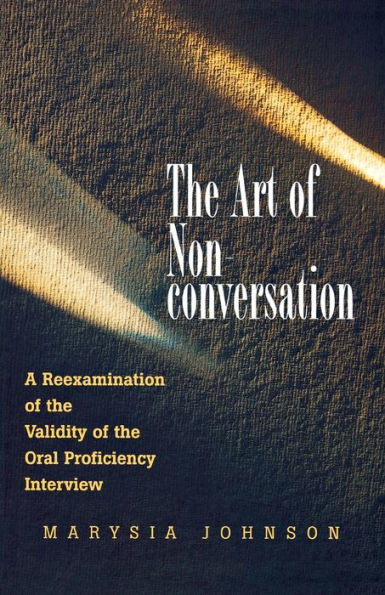The Art of Non-conversation: A Reexamination of the Validity of the Oral Proficiency Interview
The Oral Proficiency Interview (OPI) is a widely accepted instrument for assessing second and foreign language ability. It is used by the Foreign Language Institute, the Defense Language Institute, Educational Testing Service, the American Council on the Teaching of Foreign Languages, and at many universities in the United States. The Art of Non-Conversation examines the components of speaking ability and asks whether the OPI is a valid instrument for assessing them.
Marysia Johnson applies the latest insights from discourse and conversational analysis to determine the nature of the OPI’s communicative speech event and investigate its construct validity within Messick’s definition of validity. She discusses models of speaking ability—several communicative competence models, an interactional competence model, and a model of spoken interaction based on Vygotsky’s sociocultural theory of learning. Finally she proposes a new model to test language proficiency drawn from sociocultural theory, one that considers language ability to be reflective of the sociocultural and institutional contexts in which the language has been acquired.
1113568813
Marysia Johnson applies the latest insights from discourse and conversational analysis to determine the nature of the OPI’s communicative speech event and investigate its construct validity within Messick’s definition of validity. She discusses models of speaking ability—several communicative competence models, an interactional competence model, and a model of spoken interaction based on Vygotsky’s sociocultural theory of learning. Finally she proposes a new model to test language proficiency drawn from sociocultural theory, one that considers language ability to be reflective of the sociocultural and institutional contexts in which the language has been acquired.
The Art of Non-conversation: A Reexamination of the Validity of the Oral Proficiency Interview
The Oral Proficiency Interview (OPI) is a widely accepted instrument for assessing second and foreign language ability. It is used by the Foreign Language Institute, the Defense Language Institute, Educational Testing Service, the American Council on the Teaching of Foreign Languages, and at many universities in the United States. The Art of Non-Conversation examines the components of speaking ability and asks whether the OPI is a valid instrument for assessing them.
Marysia Johnson applies the latest insights from discourse and conversational analysis to determine the nature of the OPI’s communicative speech event and investigate its construct validity within Messick’s definition of validity. She discusses models of speaking ability—several communicative competence models, an interactional competence model, and a model of spoken interaction based on Vygotsky’s sociocultural theory of learning. Finally she proposes a new model to test language proficiency drawn from sociocultural theory, one that considers language ability to be reflective of the sociocultural and institutional contexts in which the language has been acquired.
Marysia Johnson applies the latest insights from discourse and conversational analysis to determine the nature of the OPI’s communicative speech event and investigate its construct validity within Messick’s definition of validity. She discusses models of speaking ability—several communicative competence models, an interactional competence model, and a model of spoken interaction based on Vygotsky’s sociocultural theory of learning. Finally she proposes a new model to test language proficiency drawn from sociocultural theory, one that considers language ability to be reflective of the sociocultural and institutional contexts in which the language has been acquired.
52.0
Out Of Stock
5
1

The Art of Non-conversation: A Reexamination of the Validity of the Oral Proficiency Interview
256
The Art of Non-conversation: A Reexamination of the Validity of the Oral Proficiency Interview
256
52.0
Out Of Stock

Product Details
| ISBN-13: | 9780300090024 |
|---|---|
| Publisher: | Yale University Press |
| Publication date: | 09/10/2001 |
| Edition description: | New Edition |
| Pages: | 256 |
| Product dimensions: | 5.50(w) x 8.25(h) x (d) |
About the Author
From the B&N Reads Blog
